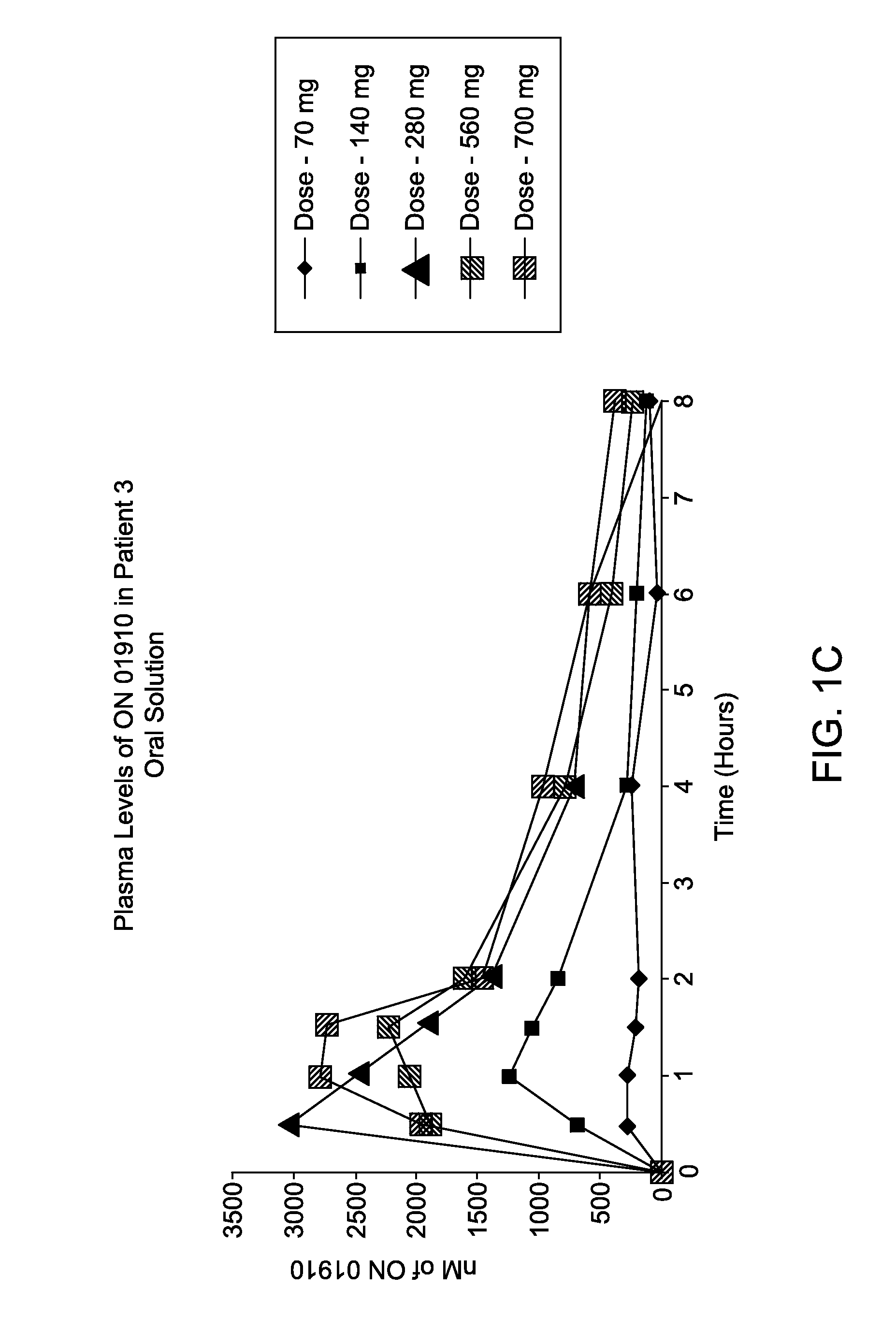Methods and compostions for treatment of cancer
a cancer and composition technology, applied in the field of cancer composition and methods for treatment, can solve the problems of cytotoxic compounds in mammals that continue to act as obstacles to successful treatment, not only fails to improve the therapeutic response, and contributes to the development of side effects and resistance to therapy
- Summary
- Abstract
- Description
- Claims
- Application Information
AI Technical Summary
Benefits of technology
Problems solved by technology
Method used
Image
Examples
example 1
Preparation of 280 mg Oral ON 01910.Na (Rigosertib) Soft Gelatin Capsules
[0110]Soft gelatin capsules of Rigosertib were composed of ON 01910.Na yellow colored oblong shaped opaque capsules containing a thick clear solution. These capsules additionally contained Gelatin, NF; Glycerin, USP; Sorbitol Sorbitan Solution, NF; Opatint White (G-18000); FD&C Yellow #6 powder; D&C Yellow #10; and Purified Water, USP. Rigosertib capsules were manufactured in 280 mg strength as follows. Each 280 mg strength capsule weighing 1000 mg contained 280 mg ON 01910.Na dissolved in 673.4 mg Polyethylene Glycol 400, NF, (Dow Chemical Company); 20 mg Polyethylene Glycol 4000, NF, (Dow Chemical Company) and 26.6 mg purified water, USP.
[0111]The manufacturing process for the 280 mg drug product involved adding ON 01910.Na to PEG 400, in a stainless steel container under a nitrogen blanket. The product was homogenized at 15° C. to 20° C. until the excipients and the drug were completely dispersed. The produc...
example 2
Preparation of 70 mg Oral ON 01910.Na (Rigosertib) Soft Gelatin Capsules
[0112]Rigosertib clear transparent oblong shaped soft gelatin capsules containing a clear solution were manufactured in 70 mg strength capsule as in Example 1. Each 70 mg strength capsule weighing 1000 mg contained 70 mg ON 01910.Na dissolved in 930 mg Polyethylene Glycol 400, NF (Dow Chemical Company). The manufacturing process for the 70 mg drug product involved adding ON 01910.Na bulk to PEG 400 in a stainless steel container under a nitrogen blanket. The product was then homogenized at 15° C. to 20° C. until the ON 01910.Na was completely dissolved. The mixture was homogenized for an additional 30-60 minutes after all of the drug was dissolved to ensure a homogenous solution. The product was then filtered through 5 micron Meissner Filter and all filtered material was collected. The product was vacuum deaerated for not less than an hour and until no air bubbles were observed. The product was encapsulated, dri...
example 3
Oral Bioavailability of Rigosertib
[0113]A Phase 1 study was conducted to assess oral bioavailability of a novel oral ON 01910.Na (Rigosertib) soft gelatin capsule formulation of Example 1 in MDS patients under fasted and fed conditions. This was a single-dose, three-treatment, three-period sequential design for studying the effects of food on the bioavailability of an immediate-release soft gelatin capsule formulation. The following dosing groups were tested in 12 patients: IV Dose 800 mg over 24 hours and oral dose 560 mg (2×280 mg capsules) under fasting and fed conditions. Plasma samples were collected pre-dose, over 32 hours (IV dose) or 8 hours (oral dose) after dose initiation. Rigosertib plasma levels were analyzed by a validated LC / MS / MS method. Pharmacokinetic parameters were estimated by non-compartmental analysis (WinNonlin®). Rigosertib pharmacokinetic parameters are presented in Table 1.
TABLE 1Pharmacokinetic Characteristics of RigosertibDosing Group800 mg IV560 mg Oral...
PUM
| Property | Measurement | Unit |
|---|---|---|
| plasma half-life | aaaaa | aaaaa |
| concentration | aaaaa | aaaaa |
| refractory | aaaaa | aaaaa |
Abstract
Description
Claims
Application Information
 Login to View More
Login to View More - R&D Engineer
- R&D Manager
- IP Professional
- Industry Leading Data Capabilities
- Powerful AI technology
- Patent DNA Extraction
Browse by: Latest US Patents, China's latest patents, Technical Efficacy Thesaurus, Application Domain, Technology Topic, Popular Technical Reports.
© 2024 PatSnap. All rights reserved.Legal|Privacy policy|Modern Slavery Act Transparency Statement|Sitemap|About US| Contact US: help@patsnap.com










